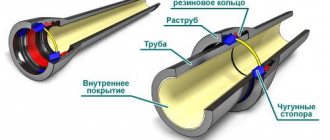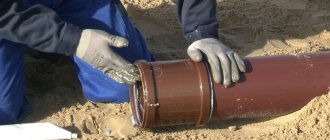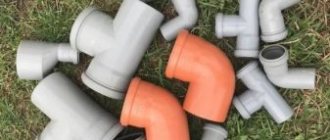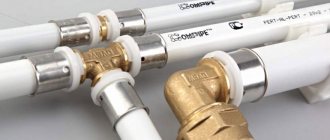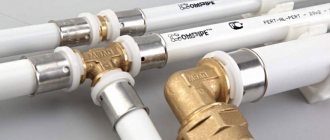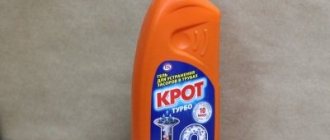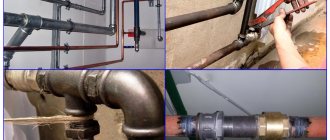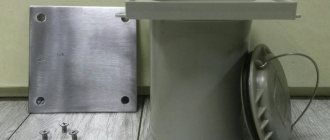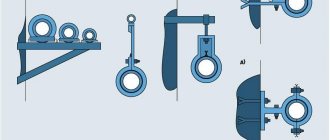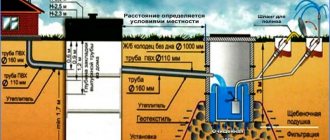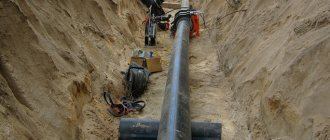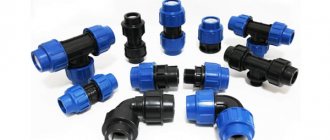Do you want to know what fittings for sewer pipes are, their sizes, types and characteristics? Make yourself comfortable, everything is in order in this article.
The basis of any sewer system is straight pipes of different diameters. However, the configuration of buildings and structures does not allow only straight lines to be laid. It is necessary to change the direction and diameter of the channels, connect or branch sections of the system. For this purpose, additional elements have been created, otherwise called fittings for sewer pipes. These are the most important components, without which the creation of a system will become impossible. We need to talk about them in more detail.
Sewage systems made of polyvinyl chloride
Relatively recently, cast iron products and metal fittings were used when installing sewer systems in private and multi-storey buildings.
To carry out installation work, it was necessary to use different welding methods, mainly electric welding. But today, when creating external and internal sewer networks, they use PVC pipes and fittings for sewerage (as they look like in the photo). The use of components made from polymer materials helps to solve many problems in the creation of utilities and pipelines (read also: “PVC pipes for sewerage - technical characteristics and installation options”). Their use also significantly reduced the cost of installing a sewer system.
Modern PVC sewer pipes and fittings have the following advantages:
- light weight - this nuance is of great importance when planning the installation of sewer systems. Lightweight products greatly facilitate the process of product delivery and installation work;
- durability - on average, sewer components, including fittings for PVC sewer pipes, can last 30-40 years. True, some manufacturers claim that their products have a service life of half a century. The fact is that these pipes and fittings are resistant to ultraviolet radiation, high humidity, various aggressive environments, and temperature changes. The internal surface of these products is not overgrown with deposits and is not covered with corrosion;
- ease of installation - all elements of the sewer system have to be assembled into a single structure manually. The use of electric and/or gas welding is not required. PVC sewer pipes and fittings are connected to each other by analogy with a construction set. You can do the installation yourself, without special training;
- large assortment - now manufacturers produce fittings for PVC sewer pipes in various variations, and this allows you to install a sewer system of the highest level of complexity;
- affordable price of products.
Reductions
The fitting for internal sewerage is produced in gray, and for external sewerage in orange or yellow. Has two outlets of different diameters. Used to connect pipes of different sizes. It is recommended to use the element in non-pressure systems. There are practically no blockages in PVC reductions. Therefore, the service life of such fittings is high.
The advantages of this part, as well as other components made of polyvinyl chloride, are:
- resistance to temperature changes;
- light weight;
- ease of installation.
The product can be used to transport chemical waste. Because the manufacturing material is inert.
Scope of application of sewer pipe fittings
Currently, plastic sewer pipes and fittings are most often used in the construction of internal sewerage systems in buildings and structures for various purposes:
- for permanent drainage of sewage, provided that the liquid temperature does not exceed 80 degrees;
- for short-term removal of wastewater (for no more than one minute), the temperature of which is no more than 95 degrees.
PVC sewer pipes and fittings are also allowed to be used to transport chemical waste if their pH is between 2 (acidic) and 12 (alkaline). If the sewer system will be used to drain industrial wastewater that has not been treated, it is necessary to ensure that it is resistant to the influence of chemical reagents. Knowing how to connect plastic sewer pipes correctly, you can do all the work yourself using fittings.
Couplings
Internal piping components come in a wide variety. These include couplings. Their design resembles a short pipe. There are sockets on the sides of the component to simplify installation. The following types of couplings are produced:
- smooth (classic);
- corrugated;
- with stiffening ribs.
The smooth version of the coupling is used most often. Their design is simple. Therefore, the cost of this element is low. Most consumers use this type of coupling. It is suitable for operation under normal loads. If the volume of negative impacts on the site is large, you need to use a different type of product. The corrugated coupling is characterized by versatility. Most of its structure consists of corrugation. Thanks to this, the component can be bent in the required direction. At the same time, the couplings do not lose their operational properties. Due to their ease of use, they are often used as an alternative to taps. Due to the fact that the inner layer is made of smooth material, blockages do not occur. For areas with increased load, it is necessary to use couplings with stiffeners. In most cases, this fitting is used in systems in which pumps drive wastewater. The key advantage of this type of coupling is its resistance to sudden pressure changes.
Types of fittings for sewerage
Fittings for PVC sewer pipes, depending on the type of sewer system, are designed:
- for installation in internal systems;
- for use in external networks.
Depending on the connection method, fittings and pipes are divided into:
- products connected “under a rubber ring”;
- elements for adhesive connection without the use of sealing rings.
Bends
When arranging pipelines, sometimes it is necessary to change the direction of the axis. To solve this problem, bends are used. The part allows you to make turns of the pipeline without transferring excessive load to the pipe. The angle of retraction may vary. There are models on sale, it can be equal to:
- fifteen degrees;
- thirty degrees;
- forty-five degrees;
- sixty-seven degrees;
- ninety degrees.
The variety of options for this fitting simplifies the creation of pipelines of any configuration. Bends are used in pressure and non-pressure sewer systems. The inner surface of the parts is a special layer of PVC. It has a smooth structure. Therefore, the part is not subject to blockages.
Installation of the outlet is simple. It is produced using the “socket” method. There is no need to use additional couplings or other fasteners to install the element. The component is secured using an O-ring.
Rubber ring fittings for internal PVC sewerage
To install internal sewerage, manufacturers produce the following fittings for plastic sewer pipes “under a rubber ring”:
- Clutch. There are several varieties of it on sale - full-bore repair and with stop.
- Reduction. It is used when the sizes of sewer pipes and fittings do not match and when switching from a cast iron pipe to a plastic product. Naturally, you need to take into account the dimensions of plastic sewer pipes when choosing components.
- An inspection with a lid is needed to carry out cleaning activities.
- Tee. Can have an angle of 45°, 67° or 90°.
- Two-plane cross. Available with an angle of 45° and 90°. It is used for sockets of different diameters.
- Single-plane cross. Can have an angle of 45° and 90°.
- Retraction. Available in 30°, 45° and 90° angles.
- Stub.
- Compensation pipe.
Installation features
To ensure maximum joint density of elements and avoid leaks, the assembly and connection of plastic pipelines is carried out in compliance with the following requirements:
- Large plastic parts are cut using a special tool - a pipe cutter. Instead, you can use a grinder or a hacksaw.
- The cut is made at a right angle to the axis of the pipe, since it will not be possible to make a tight connection if there is a distortion at the joint.
- The ends of the joined pipe sections are made as smooth as possible. The edge of the saw cut is processed with sandpaper or a file.
- The joints of the fitting elements to be glued are first degreased, then glue is applied and the parts are connected. Exposed glue is removed with a rag. When using fittings with a seal, the surface of the joints is coated with silicone sealant.
- The parts are not inserted all the way, but with a distance of 1 cm to create a compensation gap. To do this, it is necessary to make preliminary measurements and put a mark on the pipe section to limit the insertion depth.
Avoid connections at an angle of 90 degrees; it is better to replace one elbow at a right angle with two 45 degrees.
The price of pipe sections and fitting elements depends on the material, purpose and manufacturer. For example, pipe sections with a cross-section of 50 mm and a length of 500 mm made of polypropylene are sold at a price of 63 rubles. The same part of the Polytron brand can be bought for 41 rubles. A Hemkor pipe with similar dimensions, but made of uPVC, costs from 34 rubles.
Rubber ring fittings for external sewerage
When an external sewer system is created, pipes and fittings are connected “under a rubber ring” using the following elements:
- Clutch.
- Retraction. Can have an angle of 15°, 30°, 45°, 67° and 90°.
- Double socket elbow (90°). It has rubber rings on both sides.
- Tee. Available in 45°, 67° or 90° angles.
- Three-socket tee with 90° angle.
- Reduction. It is used to switch from a pipe of one diameter to a product with a different diameter.
- Stub.
- Single-plane cross. Can have an angle of 90°.
- Revision with cover.
- Check Valve. It is installed on a pipeline laid horizontally with a slope of 2 centimeters per meter.
- Double siphon.
Check valves
To ensure stable operation of the sewer system, it is necessary to take into account all the nuances. The use of a check valve in the outer part of the system avoids the flow of liquid due to clogging or flooding of the collector from the outside.
The component blocks the useful cross-section of the pipes, making flow possible in only one direction. Products come in different configurations. Some of them work automatically. Others are forced to be enabled by the control being used externally.
The check valve consists of a housing. There are connecting pipes on the sides. The locking component is located inside. It is a rubber ball or spherical unit made of a special material - vulcanized plastic. If pressure is applied to the shut-off element, it activates a membrane that closes the valve inlet, sealing it.
If this fitting is used for an extended period of time, it must be cleaned. For this purpose, a special hole is provided on the element body, closed with a lid. The component must be installed on an accessible section of the pipeline.
The shut-off valve is installed in a PVC pipe. The diameter of the products must be the same. If you need to install a fitting on a pipe of a different size, use an adapter. But it's better to avoid this. Installation of the element is simple. The check valve is mounted “in the socket”. There is no need to use sealant or plumber's tape to seal the connection to the pipe. The location of the component can be exclusively horizontal.
Fittings for adhesive method for sewerage
To connect sewer elements using the adhesive method, fittings for PVC sewer pipes are used, which are the same for both internal and external networks:
- Clutch.
- Retraction. Can have an angle of 30°, 45°, 87° and 90°.
- Tee. Available in 45°, 67° and 90° angles.
- Revision with cover.
- Reduction (adapter).
- Stub.
- Two-plane cross. Available at 45° and 90° angles.
- Saddle for glue with a socket with an angle of 90°.
- Glue saddle with a smooth end. Angle 90°. This element is used for inserting into sewer risers.
Crosspieces
In cases where it is necessary to connect several local pipelines from toilets and sinks into a riser, crosses are used. Visually, the part is a pipe of significant diameter. Two pipes are cut perpendicular to it. Based on the type of connection, products are divided into two types:
- Two-plane.
- Single-plane.
In the first case, the pipes cut into one plane. An angle is formed between them, which is one hundred and eighty degrees. For the second modification of the part it will be smaller. Products also differ in the angles of insertion of pipes. Options come with an angled insert:
- forty-five degrees;
- sixty-seven degrees;
- ninety degrees (in most cases the value varies from 87 to 88.5).
A variety of crosspieces allows you to create a system of any configuration. There are products of both equal sizes and different sizes. The first type has pipes equal in diameter to the base of the fitting, the second is smaller.
It is cost-effective to use crosspieces for local pipelines. The component has a long service life and all the other advantages of PVC fittings.
Tips for performing installation work
When installing fittings for PVC pipes for sewerage, you must adhere to the following recommendations:
- You need to cut PVC products using a saw with fine teeth, since it is this tool that leaves the smallest burrs at the cut site. You can also take a piece of cable equipped with two handles for cutting;
- then you should process the resulting edge on the cut. Removing roughness and unevenness will prevent the formation of blockages and create a tight connection between the elements;
- stripping and gluing is done dry;
- When voids form in the joint area, they must be treated with glue, applying it with a brush.
Provided that installation work is carried out correctly, pipes and fittings for laying a sewer network will last the period specified by the manufacturer.
Expansion pipes
Repairing a sewer system or inserting a new branch into an existing pipeline is a difficult task. Often, it is not technically possible to move pipes in order to add a new adapter to a certain area or replace an old, failed part. The solution to this problem is simplified by using a compensation pipe. The key purpose of the part is to compensate for the gap between pipes. The effect is achieved by lengthening the bell section.
Visually, the element is similar to a standard sewer pipe. The difference lies in the elongated bell. The design greatly simplifies repair work. The shaped element is connected to the pipeline branch and can be moved deeply and pushed back.
The connection of the compensation pipe to the place of the failed section occurs by connecting the smooth end of the coupling and the socket. It is not recommended to connect the part with pipes of a different diameter. Also, do not mount the part on an unevenly cut pipe end or on a section of pipeline that has any damage.
What types of adapters are there?
As mentioned above, various materials are used to make adapters. Details are divided into several groups:
- Transitional couplings. They are used to connect pipes of the same diameter. They are made in the form of a barrel. With such a coupling, the internal diameter is equal to the external size of the pipe used;
- Corners. Their bend is in the range of 45–90 degrees. The industry produces corners with threads on one side so that it is possible to connect a mixer;
- Crosses, as well as their analogues, tees. The parts are used in areas where several pipes are connected at the same time. Each side of the tee can have a specific diameter. There are metal tees equipped with an external thread at one end. The other end has an internal thread.
- Contours. These special devices make it possible to reduce the number of pipeline connections. Thanks to a certain bend, they can be used to bypass the pipe;
- Compensators. A device for smoothing temperature changes. The parts take on powerful shocks occurring in the system;
Adapters for different materials
You have to deal with mismatches of materials quite often. For example, plastic pipe and cast iron. Dealing with such a problem is very difficult.
There may be several reasons for the mismatch of pipeline materials:
- I would like to save money on a certain section of the highway;
- Application of new technologies;
- It is impossible to buy a part from the required material.
For example, a working water supply system was installed many years ago. The pipeline was made of steel.
To modernize the structure and replace steel pipes with polypropylene pipes, you will need adapters. With their help it will be possible to connect various materials. They connect any materials to each other. For example, a threaded adapter makes it possible to connect polypropylene to steel parts. One part is equipped with a brass thread, and the other with a plastic thread. Sometimes, instead of such a thread, the adapter is equipped with a special end for welding.
